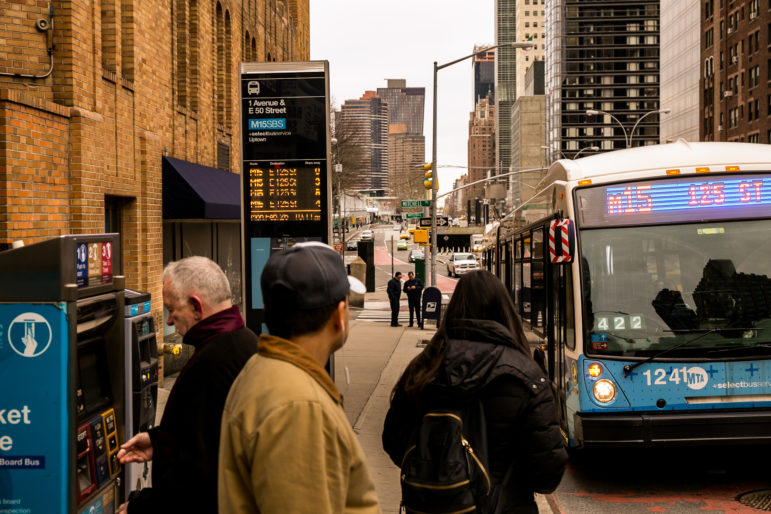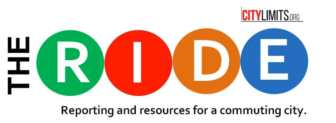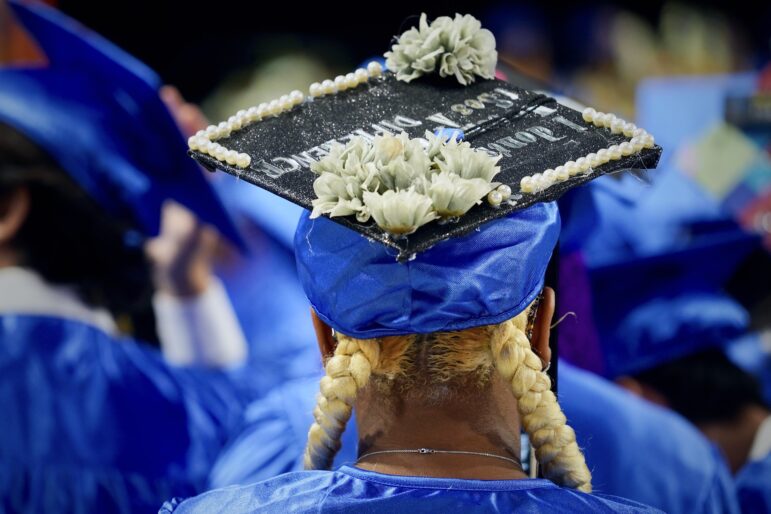
Adi Talwar
Countdown clocks (background) and off-board fare payment (at the machines on the left) are two of the innovations that the MTA has begun to install. But advocates want to see that technology offered more comprehensively.
This story is part of a series about the city’s bus system.
* * * *
Eddie Martinez lives in Yonkers and has to regularly travel to Midtown Manhattan. He says that he takes the Bx9, Bx7, and the M5. He often uses the Transit app and Google Maps.
“Sometimes, when I’m looking at the app, the app will say it’s coming within two minutes and… crickets,” he said in an email about the buses not showing up.
He understands that traffic affects when buses will arrive and that he can’t always rely on the times he sees on the app, but he’d like to see more reliable times on his phone. Martinez says he has seen a countdown clock alongside a Bx7 stop by the 231st Street subway station and would like to see technology throughout the MTA being used for making buses faster, and letting commuters know when the next buses will come.
In recent years the mayor’s office, the MTA and Gov. Cuomo have introduced several initiatives to modernize New York City’s bus technology. But advocates are pushing for more progress.
The MTA last year set a course for phasing out the MetroCard in favor of a tap-and-go payment system. Advocates like Riders Alliance have supported that effort since it could make boarding quicker.
The MTA has targeted other technology to further modernize New York’s bus service. In January, Cuomo’s office announced a three-year pilot involving at first 10 and then as many as 60 electric buses.
“This new program helps the MTA secure a cleaner and greener future while leveraging the latest in innovative advancements to push New York’s transit systems into the future,” said the governor in a statement.
Another key initiative includes expanding Select Bus Service throughout New York City. There are already several Select Bus Service routes through the city which include the B44, M15, Q44, and S79. Those buses go along bus lanes and make fewer stops. Riders pay before getting on and can board through any door.
On several routes, SBS buses also get Transit Signal Priority, which changes red lights to green quicker, and can holds green lights longer for quicker commutes. A 2017 report from the Department of Transportation outlines that, “TSP has grown to 260 intersections along five different Select Bus Service routes.”
According to a report from the Department of Transportation, the de Blasio administration has “increased capital funding by $196 million to date for SBS-related projects.” The report also credited SBS routes with increased bus speeds and fewer crashes.
Advocates press for more
In a February press release, Rider’s Alliance, a commuter advocacy group, called for faster implementation of SBS throughout the city. The group wants to “accelerate the rollout of Transit Signal Priority to 60 routes by 2020.” The group feels that SBS has helped commuters and wants to make sure there are enough select routes to help make as many parts of the city accessible. Rider’s Alliance also wants the number of countdown clocks to expand to 1,000 of the busiest bus stops by 2020.
The press release identified several busy local bus routes that could be given priority to have bus lanes installed during the 2018 painting season. It also called for strategic patrols and cameras to stop cars from using those bus lanes.
Zak Accuardi, the senior program analyst for Transit Center, says that SBS already have the technology to go faster and agrees with Riders Alliance that the rollout needs to happen quicker.
“The subway is currently in crisis. We need the city to focus on buses since those changes can take around three years as opposed to almost 10 that are needed to fix trains,” he said.
Accuardi also said that City Hall, the governor’s office and the MTA should look to cities across the country and in other countries for technological advances that could make buses reliable.
For example, San Jose’s bus system has had all-door boarding for a few years. Passengers’ cards are read at both the front and back door of the buses, allowing them to board quickly. According to a 2015 report from CityLab, having all-door boarding in San Jose has made wait-times at stops a bit shorter, allowing buses to move customers around a quicker. Though New York’s SBS buses have all-door boarding (because fares are paid at the bus stop, before people board) local buses do not and commuters have to pay at the front door, which can slow down travel time when there is a long line of on-boarding riders.
Advocates also believe the city lags others when it comes to the use of TSP. Chicago began adding TSP to its transit system in 2016 and Boston began to expand TSP and bus lanes in 2017. Chicago plans on having TSP on over 100 miles of roadway and 13 priority corridors for by the middle of 2018.
There are some routes with TSP in New York, but transit advocates want an expansion to as many buses as possible that travel along congested routes, not just SBS buses.
Accuardi also mentioned that mass transit in Seoul, South Korea gives commuters information about how crowded a train or bus is. It’s part of making the dense city “smarter” and innovative for a population that ,like New York, relies very heavily on public transportation. An article in The Sydney Morning Herald explained that the system rolled out an app in 2016 that would allow commuters to see if a bus was too full before leaving for a bus stop or before choosing what bus to take near them.
“It’s frustrating to see a bus coming in two minutes on your app and then it arrives and it’s so packed that you can’t even get on,” Accuardi said.
Jaqi Cohen, a campaign coordinator for the Straphangers Campaign says that the ideal future of the MTA bus service is one where technology is used to make ridership rise.
“Train ridership went down in the 70’s,” but has soared since, she notes. “What they did to repair subway service needs to happen with the bus,” she said.
Cohen feels that there isn’t an excuse to not use technology to make the buses better, especially when a lot of the advancements already exist, so that the MTA doesn’t have to create something completely new. And unlike train service, improving buses means making additions to buses and traffic lights that already exist. Cohen estimates that making some tweaks will be a cheaper and quicker than making a new subway station.
No gimmicks wanted
Christopher Dukas, a Forest Hills resident who regularly uses public transportation, complained online recently that the buses near him are stuck in traffic and always bunch up. He wants that issue to become the MTA’s biggest priority, and for technology to be used for fixing it: He wants there to be a way to track the buses along the route so that bunching becomes less of a problem.
“It’s inexcusable and frustrating,” said Dukas in an email.
Martinez likes riding modern buses that have added perks like charging ports and wifi—but he wants the MTA to focus bus travel faster so that he isn’t stuck in traffic for two hours.
“The buses are not getting people to their destinations on time due to traffic,” he said. “I would love to see Internet but that’s like saying I want to remodel my kitchen and meanwhile the foundation is cracked.”
Accuardi agrees, and feels like any future technological advances should focus on making the train system one that New Yorkers look forward to using, and one that commuters feel is reliable no matter what time of the day it is. He feels that as the city’s population grows, the best way to combat traffic would be to get as many people as possible in as few vehicles as possible, which means increasing bus ridership.
“The MTA has to prioritize what makes the fundamental transit experience better… we have to hold the MTA accountable to deliver that service,” he said.
Research assistance by Rolando Cruz.
What’s wrong with the city’s buses? What’s right with them?
A video by Marc Bussanich with Jarrett Murphy.










One thought on “Riders Want City to Speed Up New Technology for Buses”
SKY trains?!